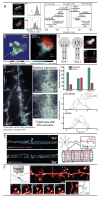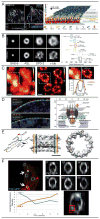Subdiffractive microscopy: techniques, applications, and challenges
- PMID: 24443323
- PMCID: PMC3930153
- DOI: 10.1002/wsbm.1259
Subdiffractive microscopy: techniques, applications, and challenges
Abstract
Cellular processes rely on the precise orchestration of signaling and effector molecules in space and time, yet it remains challenging to gain a comprehensive picture of the molecular organization underlying most basic biological functions. This organization often takes place at length scales below the resolving power of conventional microscopy. In recent years, several 'superresolution' fluorescence microscopic techniques have emerged that can surpass the diffraction limit of conventional microscopy by a factor of 2-20. These methods have been used to reveal previously unknown organization of macromolecular complexes and cytoskeletal structures. The resulting high-resolution view of molecular organization and dynamics is already changing our understanding of cellular processes at the systems level. However, current subdiffractive microscopic techniques are not without limitations; challenges remain to be overcome before these techniques achieve their full potential. Here, we introduce three primary types of subdiffractive microscopic techniques, consider their current limitations and challenges, and discuss recent biological applications.
© 2014 Wiley Periodicals, Inc.
Figures




References
-
- Gould TJ, Hess ST. Chapter 12: Nanoscale biological fluorescence imaging: breaking the diffraction barrier. Methods Cell Biol. 2008;89:329–358. - PubMed
-
- Hell SW. Far-field optical nanoscopy. Science. 2007;316:1153–1158. - PubMed
-
- Hell SW, Wichmann J. Breaking the diffraction resolution limit by stimulated emission: stimulated-emission-depletion fluorescence microscopy. Opt Lett. 1994;19:780–782. - PubMed
Publication types
MeSH terms
Substances
Grants and funding
LinkOut - more resources
Full Text Sources
Other Literature Sources

